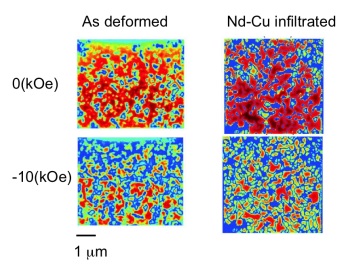
Abstract:
High coercivity mechanism in Nd-Fe-B magnet is important towards the realization of Dy-free high coercivity permanent magnets. Recent progress is Nd-Fe-B nanocrystalline hot-deformed magnet with an infiltration of Nd-Cu eutectic alloys, which enhances coercivity [1]. In Nd-Fe-B nanocrystalline magnets, grain boundaries plays an essential role in decreasing exchange interactions, and it is suggested that magnetic dipolar interaction becomes important. The significance of magnetic interactions between grains in magnetization reversal process is not well understood, since quantitative measurement of the magnetic interactions in magnetic materials is rather difficult.
In this study, we have developed a quantitative visualization method for the dipolar energy and exchange energy distributions in Nd-Fe-B nanocrystalline magnets with and without Nd-Cu infiltration process using scanning transmission x-ray microscopy (STXM) [2-4] and large-scale micromagnetic simulation. We have also performed small-angle neutron scattering (SANS) for bulk Nd-Fe-B nanocrystalline magnets to analyze the magnetic interactions between grains [5-7]
In this study, we have developed a quantitative visualization method for the dipolar energy and exchange energy distributions in Nd-Fe-B nanocrystalline magnets with and without Nd-Cu infiltration process using scanning transmission x-ray microscopy (STXM) [2-4] and large-scale micromagnetic simulation. We have also performed small-angle neutron scattering (SANS) for bulk Nd-Fe-B nanocrystalline magnets to analyze the magnetic interactions between grains [5-7]

References
[1] H. Sepehri-Amin, T. Ohkubo, S. Nagashima, M. Yano, T. Shoji, A. Kato, T. Schrefl, and K. Hono, Acta Materialia, 61,6622–6634 (2013).
[2] K. Ono, T. Araki, M. Yano, N. Miyamoto, T. Shoji, A. Kato, A. Manabe, H. Nonaki, Y. Kaneko, and J. Raabe, IEEE Trans. Magn. 47, 2672 (2011).
[3] H. Ohtori, K. Iwano, C. Mitsumata, M. Yano, A. Kato, T. Shoji, A. Manabe and K. Ono, J. Appl. Phys. 115, 17A717 (2014).
[4] H. Ohtori et al., J. Appl. Phys. 117, in press (2015).
[5] M. Yano, K. Ono, M. Harada, A. Manabe, T. Shoji, A. Kato, and J. Kohlbrecher, J. Appl. Phys. 115, 17A730 (2014).
[6] T. Ueno, K. Saito, M. Yano, M. Harada, T. Shoji, N. Sakuma, A. Manabe, A. Kato, U. Keiderling, and K. Ono , IEEE Trans. Magn. 50, 2103104 (2014).
[7] K. Saito, T. Ueno, M. Yano, M. Harada, T. Shoji, N. Sakuma, A. Manabe, A. Kato, U. Keiderling, and K. Ono J. Appl. Phys. 117, 17B302 (2015).
[1] H. Sepehri-Amin, T. Ohkubo, S. Nagashima, M. Yano, T. Shoji, A. Kato, T. Schrefl, and K. Hono, Acta Materialia, 61,6622–6634 (2013).
[2] K. Ono, T. Araki, M. Yano, N. Miyamoto, T. Shoji, A. Kato, A. Manabe, H. Nonaki, Y. Kaneko, and J. Raabe, IEEE Trans. Magn. 47, 2672 (2011).
[3] H. Ohtori, K. Iwano, C. Mitsumata, M. Yano, A. Kato, T. Shoji, A. Manabe and K. Ono, J. Appl. Phys. 115, 17A717 (2014).
[4] H. Ohtori et al., J. Appl. Phys. 117, in press (2015).
[5] M. Yano, K. Ono, M. Harada, A. Manabe, T. Shoji, A. Kato, and J. Kohlbrecher, J. Appl. Phys. 115, 17A730 (2014).
[6] T. Ueno, K. Saito, M. Yano, M. Harada, T. Shoji, N. Sakuma, A. Manabe, A. Kato, U. Keiderling, and K. Ono , IEEE Trans. Magn. 50, 2103104 (2014).
[7] K. Saito, T. Ueno, M. Yano, M. Harada, T. Shoji, N. Sakuma, A. Manabe, A. Kato, U. Keiderling, and K. Ono J. Appl. Phys. 117, 17B302 (2015).